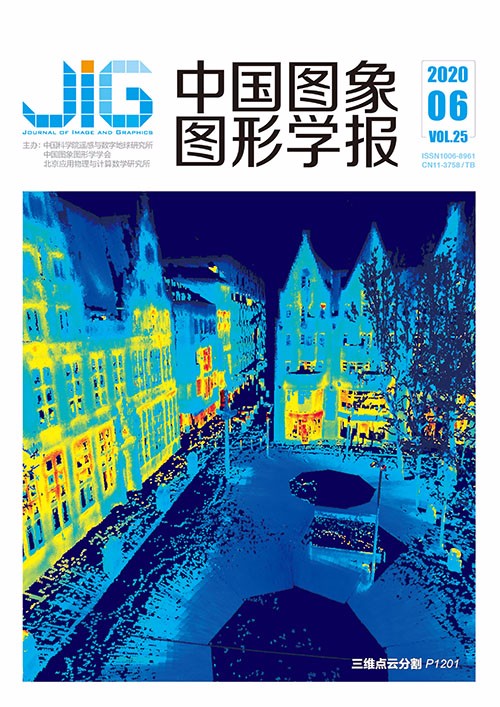
融合背景块再选取过程的显著性检测
陈星宇1, 叶锋1,2, 黄添强1,2, 翁彬1,2, 林文忠3(1.福建师范大学数学与信息学院, 福州 350117;2.数字福建大数据安全技术研究所, 福州 350117;3.福建省信息处理与智能控制重点实验室(闽江学院), 福州 350108) 摘 要
目的 显著性检测算法大多使用背景先验提高算法性能,但传统模型只是简单地将图像四周的边缘区域作为背景区域,导致结果在显著性物体触及到图像边界的情况下产生误检测。为更准确地应用背景先验,提出一种融合背景块再选取过程的显著性检测方法。方法 利用背景先验、中心先验和颜色分布特征获得种子向量并构建扩散矩阵,经扩散方法得到初步显著图,并以此为输入再经扩散方法得到二层显著图。依据Fisher准则的思想以二层显著图为基础创建背景块再选取过程,将选取的背景块组成背景向量并构建扩散矩阵,经扩散方法得到背景显著图。将背景显著图与二层显著图进行非线性融合获得最终显著图。结果 在5个通用数据集上将本文算法与6种算法进行实验对比。本文算法在MSRA10K(Microsoft Research Asia 10K)数据集上,平均绝对误差(mean absolute error,MAE)取得了最小值,与基于多特征扩散方法的显著性物体检测算法(salient object detection via multi-feature diffusion-based method,LMH)相比,F值提升了0.84%,MAE降低了1.9%;在数据集ECSSD(extended complex scene saliency dataset)上,MAE取得了次优值,F值取得了最优值,与LMH算法相比,F值提升了1.33%;在SED2(segmentation evaluation database 2)数据集上,MAE与F值均取得了次优值,与LMH算法相比,F值提升了0.7%,MAE降低了0.93%。本文算法检测结果在主观对比中均优于LMH算法,表现为检测所得的显著性物体更加完整,置信度更高,在客观对比中,查全率均优于LMH算法。结论 提出的显著性检测模型能更好地应用背景先验,使主客观检测结果有更好提升。
关键词
Saliency detection based on the background block reselection method
Chen Xingyu1, Ye Feng1,2, Huang Tianqiang1,2, Weng Bin1,2, Lin Wenzhong3(1.College of Mathematics and Informatics, Fujian Normal University, Fuzhou 350117, China;2.Digital Fujian Institute of Big Data Security Technology, Fuzhou 350117, China;3.Fujian Provincial Key Laboratory of Information Processing and Intelligent Control(Minjiang University), Fuzhou 350108, China) Abstract
Objective Many saliency detection algorithms use background priors to improve algorithm performance. In the past, however, most traditional models simply used the edge region around an image as the background region, resulting in false detection in cases wherein a salient object touches the edge of the image. To accurately apply background priors, we propose a saliency detection method that integrates the background block reselection process. Method First, the original image is segmented using a superpixel segmentation algorithm, namely, simple linear iterative clustering (SLIC), to generate a superpixel image. Then, a background prior, a central prior, and a color distribution feature are used to select a partial superpixel block from the superpixel image to form a seed vector, which constructs a diffusion matrix. Second, the seed vector is diffused by the diffusion matrix to obtain a preliminary saliency map. Then, the preliminary saliency map is used as an input and then diffused by the diffusion matrix to obtain a second saliency map to obtain high-level features. Third, we develop a background block reselection process in accordance with the idea of Fisher’s criterion. The two-layer saliency map is first fed into the background block reselection algorithm to extract background blocks. Then, we use the selected background blocks to form the background vector, which can be utilized to construct a new diffusion matrix. Lastly, the seed vector is diffused by the new diffusion matrix to obtain a background saliency map. Fourth, the background and two-layer saliency maps are nonlinearly fused to obtain the final saliency map. Result The experiments are performed on five general datasets: Microsoft Research Asia 10K (MSRA10K), extended complex scene saliency dataset (ECSSD), Dalian University of Technology and OMRON Corporation (DUT-OMRON), salient object dataset (SOD), and segmentation evaluation database 2 (SED2). Our method is compared with six recent algorithms, namely, generic promotion of diffusion-based salient object detection (GP), inner and inter label propagation: salient object detection in the wild (LPS), saliency detection via cellular automata (BSCA), salient object detection via structured matrix decomposition (SMD), salient region detection using a diffusion process on a two-layer sparse graph (TSG), and salient object detection via a multifeature diffusion-based method LMH (salient object detection via multi-feature diffusion-based method), by using three evaluation indicators: PR(precision-recall) curve, F index, and mean absolute error (MAE). On the MSRA10K dataset, MAE achieved the minimum value in all the comparison algorithms. Compared with the preimproved algorithm LMH, the F value increased by 0.84% and MAE decreased by 1.9%. On the ECSSD dataset, MAE was the second and the F value reached the maximum value in all the methods. Compared with the algorithm LMH, the F value increased by 1.33%. On the SED2 dataset, MAE and F values were both second in all the methods. Compared with the algorithm LMH, the F value increased by 0.7% and MAE decreased by 0.93%. Simultaneously, we separately extract the generated background saliency map and the final saliency map from our method and compare them with the corresponding high-level saliency map and final saliency map generated using the algorithm LMH. The experiment shows that our method also performs better at the subjective level. The salient objects in the saliency map are more complete and exhibit higher confidence, which is consistent with the phenomenon that recall rate in the objective comparison is better than that of the algorithm LMH. In addition, we experimentally verify the process of dynamically selecting thresholds in the proposed background block reselection process. The F-indexes obtained on three datasets (MSRA10K, SOD, and SED2) are better than those in the corresponding static processes. On ECSSD, the performance on the dataset is basically the same as that in the static process. However, the performance on the DUT-OMRON dataset is not as good as that in the static process. Consequently, we conduct theoretical analysis and verify the experiment by increasing the selection interval of the background block. Conclusion The proposed saliency detection method can better apply the background prior, such that the final detection effect is better at the subjective and objective indicator levels. Simultaneously, the proposed method performs better when dealing with the type of image in which the salient region touches the edge of the image. In addition, the comparative experiment on the dynamic selection process of thresholds shows that the process of dynamically selecting thresholds is effective and reliable.
Keywords
saliency detection background priori re-selection of background block Fisher criterion diffusion method
|



 中国图象图形学报 │ 京ICP备05080539号-4 │ 本系统由
中国图象图形学报 │ 京ICP备05080539号-4 │ 本系统由